The global lime spreader market is valued at USD 301.5 million in 2025 and is projected to reach USD 468.3 million by 2035, expanding at a CAGR of 4.5% and adding USD 166.8 million in absolute value during the forecast period. The demand for lime spreaders contributes to the total growth of 55.3% and a market size increase of approximately 1.6X, shaped by the rising adoption of precision agriculture equipment and mechanized soil management solutions. Regional dynamics indicate that North America will maintain a dominant position, driven by strong mechanization trends, large-scale commercial farming, and the increasing adoption of precision soil management systems in the United States and Canada. Farmers in these regions are actively adopting advanced lime spreaders with GPS integration and variable-rate technologies to improve fertilizer efficiency and optimize crop yields.
Europe is expected to record stable growth, with countries such as Germany, France, and the UK focusing on sustainable farming practices, soil health regulations, and nutrient balance requirements. Adoption will be accelerated by EU policy frameworks that encourage the precise application of soil amendments and the reduction of input wastage.
Asia Pacific is projected to show the fastest expansion, driven by increasing mechanization in India, China, and Southeast Asia. The rapid transformation of farming systems, coupled with government-backed programs aimed at improving soil fertility management, is creating significant opportunities. Smaller-scale lime spreaders suited for fragmented landholdings are likely to see strong demand, particularly in emerging agricultural economies.
Latin America, led by Brazil and Argentina, is poised for steady growth as large commercial farms adopt mechanized spreaders to enhance efficiency in cash crop cultivation. Meanwhile, the Middle East and Africa are expected to witness gradual adoption, with lime spreaders increasingly used to manage soil alkalinity and improve productivity in arid farming environments. Regional trends indicate that mature markets will focus on technology integration and sustainable farming compliance, while emerging regions will contribute through mechanization adoption and expansion of arable land use. Manufacturers targeting both premium precision systems for developed regions and cost-efficient models for developing countries will be best positioned to capture market share.
Between 2025 and 2030, the lime spreader market is projected to expand from USD 301.5 million to USD 372.4 million, resulting in a value increase of USD 70.9 million, which represents 42.5% of the total forecast growth for the decade. This phase of development will be shaped by increasing demand for agricultural mechanization solutions, rising crop yield optimization patterns enabling efficient field management formats, and growing availability of advanced spreading technologies across commercial farming operations and specialty agricultural equipment facilities.
Between 2030 and 2035, the lime spreader market is forecast to grow from USD 372.4 million to USD 468.3 million, adding another USD 95.9 million, which constitutes 57.5% of the overall ten-year expansion. This period is expected to be characterized by the advancement of precision application systems, the integration of GPS-guided spreading technologies for material optimization, and the development of premium capacity options across diverse agricultural categories. The growing emphasis on soil health management and precision agriculture principles will drive demand for advanced spreader varieties with enhanced distribution accuracy, improved operational efficiency, and superior functionality characteristics.
| Metric | Value |
|---|---|
| Estimated Value in (2025E) | USD 301.5 million |
| Forecast Value in (2035F) | USD 468.3 million |
| Forecast CAGR (2025 to 2035) | 4.5% |
The agriculture machinery market is the largest contributor, accounting for approximately 40-45%. Lime spreaders are essential in agriculture for spreading lime to neutralize soil acidity, promote healthy crop growth, and improve soil quality. With increasing demand for high-yield crops and soil management solutions, lime spreaders are widely used in both large-scale farming operations and smaller agricultural settings. The fertilizer and soil treatment market holds around 25-30%, as lime is a key product used to improve soil pH and provide essential nutrients for crops. The demand for lime spreaders in this market is driven by the need for efficient application of soil amendments, particularly in regions with acidic soils that require regular lime application for optimal crop growth.
The construction and mining market contributes approximately 15-18%, as lime spreaders are used in large construction and mining projects for soil stabilization, road construction, and reclamation efforts. Lime is often spread on construction sites to enhance the stability and load-bearing capacity of the soil, making it easier to build roads, foundations, and other structures. The environmental services market represents about 10-12%, as lime spreaders are used in waste management applications, such as in land reclamation, water treatment, and managing acidic mine runoff. The landscape and turf management market contributes around 5-8%, where lime spreaders are used for soil conditioning in golf courses, sports fields, and commercial landscaping projects.
Market expansion is being supported by the increasing global demand for agricultural mechanization solutions and the corresponding shift toward precision equipment that can provide superior application characteristics while meeting user requirements for soil treatment optimization and material-efficient spreading processes. Modern farmers are increasingly focused on incorporating equipment formats that can enhance field productivity while satisfying demands for consistent, reliably performing spreaders and optimized agricultural practices. Lime spreaders' proven ability to deliver uniform distribution, operational efficiency, and diverse application possibilities makes them essential equipment for crop producers and quality-conscious agricultural operators.
The growing emphasis on soil health management and farm productivity optimization is driving demand for high-performance lime spreader systems that can support distinctive field positioning and comprehensive soil improvement across crop production, pasture management, and specialty agriculture categories. User preference for equipment that combines functional excellence with operational flexibility is creating opportunities for innovative implementations in both traditional and emerging agricultural applications. The rising influence of precision agriculture practices and modern farming infrastructure is also contributing to increased adoption of lime spreaders that can provide authentic performance benefits and reliable operational characteristics.
The lime spreader market is segmented by type, capacity, application, and region. By type, the lime spreader market is divided into traction type, suspension type, pneumatic type, and others. Based on capacity, the lime spreader market is categorized into below 2 tons, 2-5 tons, 5-10 tons, and above 10 tons. By application, the lime spreader market encompasses farmland, orchards, pastures, and others. Regionally, the market is divided into North America, Europe, Asia Pacific, Latin America, the Middle East & Africa, and other regions.
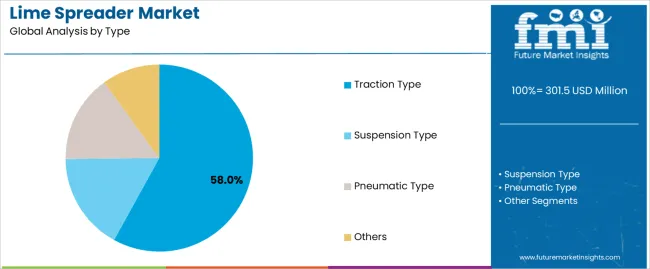
The traction type segment is projected to account for 58% of the lime spreader market in 2025, reaffirming its position as the leading equipment category. Agricultural operators and farming facilities increasingly utilize traction type spreaders for their superior operational reliability characteristics, established field performance efficiency, and essential functionality in diverse spreading applications across multiple crop categories. Traction type spreaders' standardized operational characteristics and proven cost-effectiveness directly address user requirements for reliable equipment performance and optimal agricultural value in commercial applications.
This equipment segment forms the foundation of modern lime spreading operations, as it represents the format with the greatest operational scalability potential and established compatibility across multiple tractor systems. Business investments in power transmission optimization and operational standardization continue to strengthen adoption among efficiency-conscious operators. With users prioritizing operational reliability and application precision, traction type spreaders align with both economic objectives and performance requirements, making them the central component of comprehensive soil management strategies.
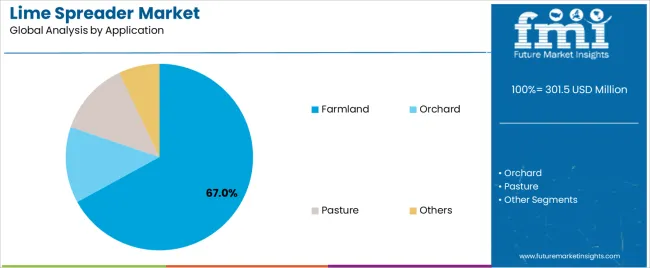
Farmland is projected to represent 67% of the lime spreader market in 2025, underscoring its critical role as the primary application for performance-focused operations seeking superior soil treatment benefits and enhanced crop production credentials. Agricultural operators and crop producers prefer farmland applications for their established cultivation patterns, proven yield enhancement potential, and ability to maintain exceptional soil health profiles while supporting versatile crop offerings during diverse growing experiences. Positioned as essential applications for quality-conscious farmers, farmland offerings provide both productivity excellence and operational advantages.
The segment is supported by continuous improvement in precision application technology and the widespread availability of established agronomic practices that enable soil optimization and premium positioning at the production level. Farming operations are optimizing equipment utilization to support crop differentiation and accessible management strategies. As agricultural technology continues to advance and producers seek efficient soil treatment formats, farmland applications will continue to drive market growth while supporting yield optimization and farm profitability strategies.
The lime spreader market is advancing steadily due to increasing agricultural mechanization consciousness and growing need for precision application equipment choices that emphasize superior soil treatment outcomes across crop production segments and specialty farming applications. The lime spreader market faces challenges, including competition from alternative soil treatment methods, regulatory pressures on agricultural chemicals, and equipment cost pressures affecting farm investment economics. Innovation in precision application integration and advanced spreading systems continues to influence market development and expansion patterns.
The growing adoption of lime spreaders with precision agriculture capabilities and GPS-guided application systems is enabling operators to develop field management patterns that provide distinctive soil treatment benefits while commanding operational efficiency positioning and enhanced accuracy characteristics. Precision applications provide superior distribution control while allowing more sophisticated variable rate features across various field categories. Users are increasingly recognizing the functional advantages of integrated spreader positioning for premium soil management and efficiency-conscious agricultural integration.
Modern lime spreader manufacturers are incorporating advanced capacity management technologies, multi-material handling capabilities, and versatile application systems to enhance operational credentials, improve field productivity outcomes, and meet commercial demands for efficient agricultural solutions. These systems improve material effectiveness while enabling new applications, including blend application capabilities and material versatility programs. Advanced capacity integration also allows operators to support productivity leadership positioning and operational optimization beyond traditional spreading operations.
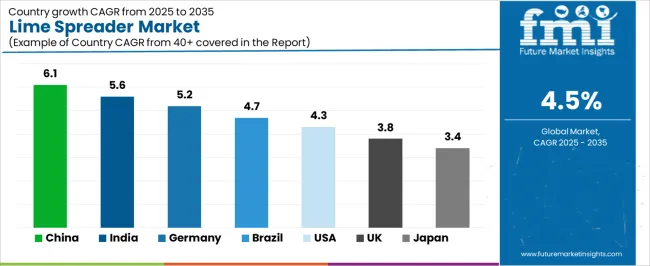
| Country | CAGR (2025-2035) |
|---|---|
| China | 6.1% |
| India | 5.6% |
| Germany | 5.2% |
| Brazil | 4.7% |
| USA | 4.3% |
| UK | 3.8% |
| Japan | 3.4% |
The lime spreader market is experiencing moderate growth globally, with China leading at a 6.1% CAGR through 2035, driven by the expanding mechanized agriculture sector, growing crop production optimization, and increasing adoption of modern farming equipment. India follows at 5.6%, supported by rising agricultural mechanization trends, expanding farm productivity initiatives, and growing acceptance of precision farming solutions. Germany shows growth at 5.2%, emphasizing established agricultural machinery capabilities and comprehensive farming development. Brazil records 4.7%, focusing on large-scale farming operations and equipment modernization. The USA demonstrates 4.3% growth, prioritizing precision agriculture solutions and technological advancement.
The report covers an in-depth analysis of 40+ countries, with top-performing countries highlighted below.
Revenue from lime spreader consumption and sales in China is projected to exhibit exceptional growth with a CAGR of 6.1% through 2035, driven by the country's rapidly expanding agricultural mechanization sector, favorable government policies toward modern farming equipment, and initiatives promoting farming efficiency optimization across major agricultural regions. China's position as a leading agricultural producer and increasing focus on crop yield enhancement are creating substantial demand for high-quality lime spreaders in both commercial and specialty markets. Major agricultural equipment manufacturers and farming cooperatives are establishing comprehensive spreading capabilities to serve growing demand and emerging market opportunities.
Demand for lime spreader products in India is expanding at a CAGR of 5.6%, supported by rising agricultural mechanization, growing crop diversification requirements, and expanding farming infrastructure. The country's developing mechanization capabilities and increasing commercial investment in advanced equipment are driving demand for lime spreaders across both traditional and modern agricultural applications. International equipment companies and domestic manufacturers are establishing comprehensive operational networks to address growing market demand for quality lime spreaders and efficient soil management solutions.
Revenue from lime spreader products in Germany is projected to grow at a CAGR of 5.2% through 2035, supported by the country's mature agricultural machinery market, established farming culture, and leadership in equipment engineering. Germany's sophisticated agricultural infrastructure and strong support for farming innovation are creating steady demand for both traditional and innovative lime spreader varieties. Leading equipment manufacturers and specialty producers are establishing comprehensive operational strategies to serve both domestic markets and growing export opportunities.
Demand for lime spreader products in Brazil is anticipated to expand at a CAGR of 4.7% through 2035, driven by the country's emphasis on agricultural expansion, farming productivity leadership, and sophisticated production capabilities for equipment requiring specialized agricultural varieties. Brazilian farmers and distributors consistently seek commercial-grade equipment that enhances field productivity and supports farming operations for both traditional and innovative crop applications. The country's position as a South American agricultural leader continues to drive innovation in specialty lime spreader applications and commercial production standards.
Revenue from lime spreader products in the USA is projected to grow at a CAGR of 4.3% through 2035, supported by the country's emphasis on precision agriculture, equipment standards, and advanced technology integration requiring efficient spreading solutions. American farmers and agricultural businesses prioritize operational performance and technological precision, making lime spreaders essential equipment for both traditional and modern farming applications. The country's comprehensive agricultural excellence and advancing mechanization patterns support continued market expansion.
Demand for lime spreader products in the UK is growing at a CAGR of 3.8% through 2035, supported by established agricultural practices, modern farming adoption, and comprehensive soil management requirements across diverse crop categories. British farmers and agricultural enterprises recognize lime spreaders as essential equipment for maintaining soil health and supporting efficient field operations in both traditional and specialty applications. The country's agricultural heritage and advancing equipment adoption support steady market development.
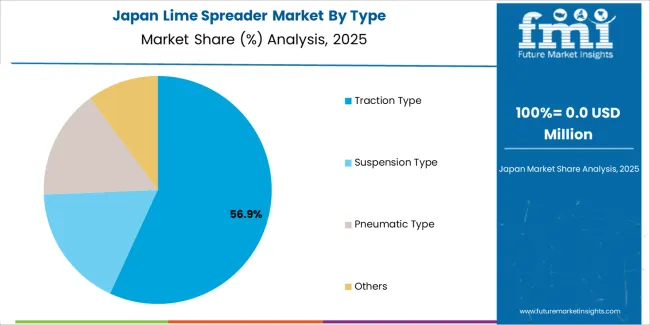
Revenue from lime spreader products in Japan is expanding at a CAGR of 3.4% through 2035, supported by the country's focus on agricultural technology, precision farming practices, and advanced equipment integration requiring efficient soil treatment solutions. Japanese agricultural operations and farming enterprises prioritize equipment performance and operational precision, making lime spreaders valuable machinery for both rice production and diversified crop applications. The country's technological expertise and advancing agricultural patterns support continued market stability.
The Europe lime spreader market is projected to grow from USD 89.2 million in 2025 to USD 132.1 million by 2035, recording a CAGR of 4.0% over the forecast period. Germany leads the region with a 42.0% share in 2025, moderating slightly to 41.5% by 2035, supported by its strong agricultural machinery base and demand for premium, technically advanced spreading equipment. The United Kingdom follows with 18.0% in 2025, easing to 17.5% by 2035, driven by a sophisticated farming market and emphasis on precision agriculture and operational efficiency standards. France accounts for 16.5% in 2025, rising to 17.0% by 2035, reflecting steady adoption of mechanized farming solutions and operational optimization. Italy holds 9.0% in 2025, expanding to 9.5% by 2035 as agricultural modernization and specialty crop applications grow. Spain contributes 6.5% in 2025, growing to 7.0% by 2035, supported by expanding agricultural sector and equipment handling. The Nordic countries rise from 5.0% in 2025 to 5.5% by 2035 on the back of strong agricultural technology adoption and advanced farming practices. BENELUX remains at 3.0% share across both 2025 and 2035, reflecting mature, efficiency-focused markets.
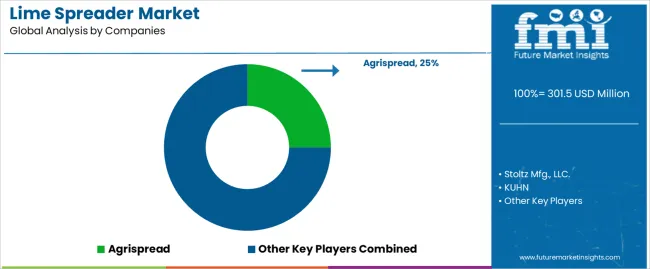
The lime spreader market is characterized by competition among established agricultural equipment manufacturers, specialized spreading equipment producers, and integrated farming solution companies. Companies are investing in spreading mechanism technologies, advanced capacity systems, product innovation capabilities, and comprehensive distribution networks to deliver consistent, high-quality, and reliable lime spreader systems. Innovation in precision application enhancement, durability improvement methods, and application-specific product development is central to strengthening market position and customer satisfaction.
Agrispread leads the lime spreader market with a strong focus on agricultural innovation and comprehensive lime spreader solutions, offering commercial spreading systems with emphasis on manufacturing excellence and operational heritage. Stoltz Mfg., LLC. provides specialized agricultural equipment capabilities with a focus on North American market applications and engineering networks. KUHN delivers integrated agricultural machinery solutions with a focus on farming positioning and operational efficiency. AGRO-MASZ specializes in comprehensive spreading equipment with an emphasis on commercial applications. Pequea focuses on comprehensive agricultural and specialty spreaders with advanced design and premium positioning capabilities.
The success of lime spreaders in meeting commercial agricultural demands, farmer-driven productivity requirements, and performance integration will not only enhance soil management outcomes but also strengthen global agricultural equipment manufacturing capabilities. It will consolidate emerging regions' positions as hubs for efficient equipment production and align advanced economies with commercial agricultural systems. This calls for a concerted effort by all stakeholders -- governments, industry bodies, manufacturers, distributors, and investors. Each can be a crucial enabler in preparing the lime spreader market for its next phase of growth.
How Governments Could Spur Local Production and Adoption?
How Industry Bodies Could Support Market Development?
How Distributors and Agricultural Industry Players Could Strengthen the Ecosystem?
How Manufacturers Could Navigate the Shift?
| Items | Values |
|---|---|
| Quantitative Units (2025) | USD 301.5 million |
| Type | Traction Type, Suspension Type, Pneumatic Type, Others |
| Capacity | Below 2 tons, 2-5 tons, 5-10 tons, Above 10 tons |
| Application | Farmland, Orchard, Pasture, Others |
| Regions Covered | North America, Europe, Asia Pacific, Latin America, Middle East & Africa, Other Regions |
| Countries Covered | China, India, Germany, Brazil, United States, United Kingdom, Japan, and 40+ countries |
| Key Companies Profiled | Agrispread, Stoltz Mfg., LLC., KUHN, AGRO-MASZ, Pequea, and other leading lime spreader companies |
| Additional Attributes | Dollar sales by type, capacity, application, and region; regional demand trends, competitive landscape, technological advancements in spreading engineering, precision integration initiatives, capacity enhancement programs, and premium product development strategies |
The global lime spreader market is estimated to be valued at USD 301.5 million in 2025.
The market size for the lime spreader market is projected to reach USD 468.3 million by 2035.
The lime spreader market is expected to grow at a 4.5% CAGR between 2025 and 2035.
The key product types in lime spreader market are traction type , suspension type, pneumatic type and others.
In terms of application, farmland segment to command 67.0% share in the lime spreader market in 2025.






Full Research Suite comprises of:
Market outlook & trends analysis
Interviews & case studies
Strategic recommendations
Vendor profiles & capabilities analysis
5-year forecasts
8 regions and 60+ country-level data splits
Market segment data splits
12 months of continuous data updates
DELIVERED AS:
PDF EXCEL ONLINE
Lime Seed Oils Market Size and Share Forecast Outlook 2025 to 2035
Millimeter Wave Technology Market Size and Share Forecast Outlook 2025 to 2035
Millimeter Wave Sensors Market by Devices, Frequency Band, Application & Region Forecast till 2025 to 2035
U.S. Lime Market Trends & Forecast 2016-2026
5G Millimeter Wave RF Transceiver Market Size and Share Forecast Outlook 2025 to 2035
Hydrated Lime Market Size and Share Forecast Outlook 2025 to 2035
Telecom Millimeter Wave Technology Market Size and Share Forecast Outlook 2025 to 2035
Marine Spreader Lights Market Size and Share Forecast Outlook 2025 to 2035
Hydraulic Spreader Market
Wet Fertilizer Spreaders Market
Agriculture Fertilizer Spreader Market Size and Share Forecast Outlook 2025 to 2035

Thank you!
You will receive an email from our Business Development Manager. Please be sure to check your SPAM/JUNK folder too.
Chat With
MaRIA